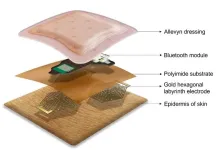(Press-News.org) A new compact, lightweight, gel-free and waterproof electrocardiogram (ECG) sensor offers more comfort and less skin irritation, compared to similar heart monitoring devices on the market.
ECGs help manage cardiovascular disease – which affects around 4 million Australians and kills more than 100 people every day – by alerting users to seek medical care.
The team led by RMIT University in Australia has made the wearable ECG device that could be used to prevent heart attacks for people with cardiovascular disease, including in remote healthcare and ambulatory care settings. While most wearable ECG monitors typically weigh a few hundred grams, the RMIT device weighs only 10 grams.
The latest research is published in AIP Applied Physics Reviews.
Lead author PhD scholar Peter Elango from RMIT said heart attacks often occurred with little or no warning, as signals were difficult to spot without continuous monitoring.
“Nearly half of the people who have heart attacks do not realise what’s happening until it’s too late,” Elango said.
“My dream is a world with zero preventable heart attacks.”
Elango was one of the top 10 competitors at the recent Falling Walls Lab Australia 2023 Final at the Australian Shine Dome in Canberra, where he gave a pitch about the ECG device.
RMIT has filed an international patent (PCT) application to protect the ECG device that the team developed.
“RMIT is exploring ways to translate the work into a commercial product, and we are in discussions with partners regarding potential licensing opportunities,” Elango said.
Optimising design and comfort
Professor Madhu Bhaskaran, Deputy Director (Research) of the ARC Hub for Connected Sensors for Health at RMIT said the team’s focus was on improving the electrode design and materials for increased performance as well as comfort.
“Commercially available wearable ECG devices are usually bulky, heavy and have 12 ‘wet’ electrodes connecting the patient to the device, whereas the RMIT invention can fit in the palm of your hand,” Bhaskaran said.
“The device has just three ‘dry’ electrodes that are almost invisibly thin, can sense even the slightest signals of a heart in distress, and can also be recycled.”
Wet electrodes contain a conductive gel to increase cardiac signals, while dry electrodes do not need this gel to operate effectively.
“Wet electrodes are uncomfortable, dry out over time and have been known to cause skin irritation,” Bhaskaran said.
The team’s experiments tested the RMIT miniaturised three-electrode ECG device’s sensing performance against a 12-electrode wearable monitor on the market, demonstrating a comparable level of precision in capturing the heart’s electrical activity.
“The RMIT device efficiently captures the heart’s activity, whether the user is at rest or experiencing stress,” Bhaskaran said.
Enabling continuous monitoring
ECG data recorded over time helps obtain important diagnostic information concerning the activity of the patient's heart.
To conduct continuous monitoring, Elango said dry electrodes offered some significant advantages.
“Dry electrodes prioritise user comfort, remain durable over time and reduce the likelihood of skin irritation,” Elango said.
“The electrodes are also hydrophobic, meaning they don’t get wet, and so a user can wear the device while they do activities in the water such as swimming and showering – unlike other ECG monitors.
“These attributes make them ideal for continuous monitoring – a crucial feature for wearable ECG devices.”
After extensive experimentation, the team discovered that a hexagonal design was the “winning formula”, as it suits the curvy nature of skin and active lifestyles and more accurately captures ECG signals, compared with other wearable devices on the market.
“The device can capture ECG signals even when it is fitted behind a person’s neck – ideal for patients in the aged care sector, including for someone with dementia who may remove it from their chest.”
But it wasn't all about design aesthetics, Elango said.
“We also dived into the nitty gritty of how different body areas influence ECG measurements. This yielded valuable insights to enhance sensor performance,” he said.
“The dry electrodes, which are less than one tenth the width of a human hair, are highly sensitive to the cardiac signals of the user.”
Support for the research
This work was performed in part at the Micro Nano Research Facility at RMIT in the Victorian Node of the Australian National Fabrication Facility (ANFF). The team acknowledges the support and funding from the Cooperative Research Centres Projects and ARC Research Hub for Connected Sensors for Health.
RMIT led this research in collaboration with Dr Sherly Elango from Annamalai University in India.
The paper ‘Dry electrode geometry optimization for wearable ECG devices’ is published in AIP Applied Physics Reviews (DOI: 10.1063/5.0152554).
You can link directly to the research paper via: Dry electrode geometry optimization for wearable ECG devices | Applied Physics Reviews | AIP Publishing
MULTIMEDIA AVAILABLE
You can watch a short RMIT video about the ECG innovation here: Wearable heart monitor ticks all the boxes for better healthcare | RMIT University - YouTube
The video will be unlisted until tomorrow morning, when it will be made public.
Illustrations/images, a short video and b-roll video footage of the lead researchers and their work are available via this link: https://cloudstor.aarnet.edu.au/plus/s/vJKG0EVCwUBFrGh
END
Wearable heart monitor ticks all the boxes for better healthcare: Study
2023-10-31
ELSE PRESS RELEASES FROM THIS DATE:
Binghamton researchers get FDA approval for drug to treat world’s most common genetic disease
2023-10-31
BINGHAMTON, N.Y. -- A new drug developed by professors from the School of Pharmacy and Pharmaceutical Sciences at Binghamton University has received Food and Drug Administration (FDA) approval for the treatment of patients with Duchenne muscular dystrophy (DMD), a common genetic disease that mostly affects young boys.
DMD is the most common genetic disease. It leads to the loss of the dystrophin protein in muscle tissues, with progressive weakness and challenges with day-to-day activities. The DMD gene is the largest gene in the human genome, ...
Trastuzumab deruxtecan: advantages also in HER2-low breast cancer
2023-10-31
The antibody-drug conjugate trastuzumab deruxtecan is approved for various therapeutic indications. Since March 2023, it can also be used as monotherapy for the treatment of adults with unresectable or metastatic HER2-low breast cancer who have received prior chemotherapy at this disease stage or developed disease recurrence early after adjuvant chemotherapy. Treatment with trastuzumab deruxtecan is the first approved therapy for patients with HER2-low breast cancer. The German Institute for Quality and Efficiency in Health Care (IQWiG) examined in an early benefit assessment whether the antibody-drug ...
Children with ADHD frequently use healthcare service before diagnosis, study finds
2023-10-31
Children and young people with attention deficit hyperactivity disorder (ADHD) use healthcare services twice as often in the two years before their diagnosis, a study by researchers at the University of Nottingham and King’s College London has found.
The research, published today in the journal Archives of Disease in Childhood shows that children with the neurodevelopmental disorder are twice as likely to see their GP, go to hospital for an admission, and even have operations, compared to children without ADHD.
The researchers say the results support the need for healthcare professionals to consider a potential diagnosis of ADHD in children who ...
The first oncogene was found more than 40 years ago. CNIO researchers have just discovered that it has a previously unknown mechanism of action
2023-10-31
In the late 1970s, the relationship between the c-Src gene and cancer was discovered. The first oncogene was identified.
Since then, c-Src has been found to be overactivated in half of colon, liver, lung, breast, prostate and pancreatic tumors, but its function is not yet fully understood.
CNIO researchers have now discovered that this oncogene is capable of 'self-activation', by means of a previously undescribed molecular mechanism. This finding has implications for the development of new drugs.
In ...
First classification of four stages of heart attack based on heart muscle damage is released
2023-10-31
Philadelphia, October 31, 2023 – Heart attacks, or acute myocardial infarction (MI), are one of the leading causes of death worldwide. The newly released Canadian Cardiovascular Society Classification of Acute Myocardial Infarction (CCS-AMI) appearing in the Canadian Journal of Cardiology, published by Elsevier, presents a four-stage classification of heart attack based on heart muscle damage. This work by a group of noted experts has the potential to stratify risk more accurately in heart attack patients and lays the groundwork for development of new, injury-stage-specific and tissue ...
New techniques efficiently accelerate sparse tensors for massive AI models
2023-10-31
Researchers from MIT and NVIDIA have developed two techniques that accelerate the processing of sparse tensors, a type of data structure that’s used for high-performance computing tasks. The complementary techniques could result in significant improvements to the performance and energy-efficiency of systems like the massive machine-learning models that drive generative artificial intelligence.
Tensors are data structures used by machine-learning models. Both of the new methods seek to efficiently exploit what’s ...
The world’s first collection of brain metastasis living samples will help treat each patient with the most effective therapy for them
2023-10-31
A paper published in Trends in Cancer explains the advantages of RENACER, the world’s first repository of live brain metastases samples, created by researchers at CNIO.
Live samples allow researchers to study the way cancer cells respond to drugs. This paves the way to create avatars for each individual patient to test out possible therapies before applying them.
RENACER is made up of around twenty hospitals, who attended their first general assembly meeting today at the Fundación Ramón Areces, the foundation that is funding the ...
Hey, Siri: Moderate AI voice speed encourages digital assistant use
2023-10-31
UNIVERSITY PARK, Pa. — Voice speed and interaction style may determine whether a user sees a digital assistant like Alexa or Siri as a helpful partner or something to control, according to a team led by Penn State researchers. The findings reveal insights into the parasocial, or one-sided, relationships that people can form with digital assistants, according to the researchers.
They reported their findings in the Journal of Business Research.
“We endow these digital assistants with personalities and human characteristics, and it impacts how we interact with the devices,” said Brett Christenson, assistant clinical professor of marketing at Penn State and first author ...
How cruise ships can steer clear of viral spread
2023-10-31
WASHINGTON, Oct. 31, 2023 – When COVID-19 began to spread across the globe, its effects were significantly pronounced on cruise ships. Indeed, compared to other population segments, cruise ship passengers became disproportionately infected and often, ironically, stranded on board to quarantine. That’s why focus has been directed at addressing the need for improved ventilation on cruise ships – since dispersing fresh air in cabins and other enclosed spaces is critical for mitigating viral spread.
In Physics of Fluids, by AIP Publishing, a group of researchers from Cyprus examined how ventilation can affect ...
Masks during pandemics caused by respiratory pathogens— evidence and implications for action
2023-10-31
About The Study: Robust available data support the use of face masks in community settings to reduce transmission of SARS-CoV-2 and should inform future responses to epidemics and pandemics caused by respiratory viruses.
Authors: Shama Cash-Goldwasser, M.D., M.P.H., of Resolve to Save Lives in New York, is the corresponding author.
To access the embargoed study: Visit our For The Media website at this link https://media.jamanetwork.com/
(doi:10.1001/jamanetworkopen.2023.39443)
Editor’s Note: Please see the article for additional information, including other authors, ...





